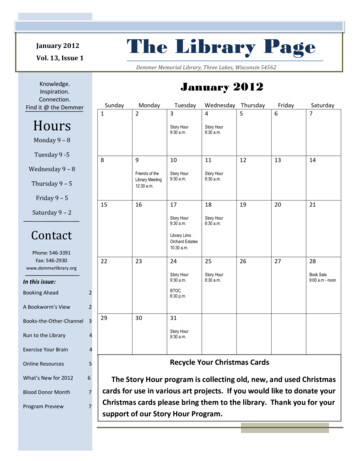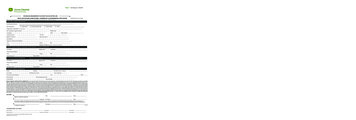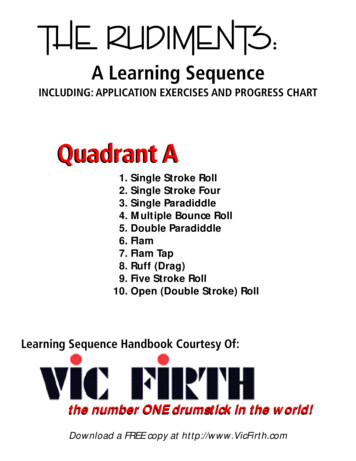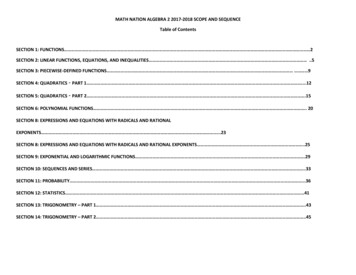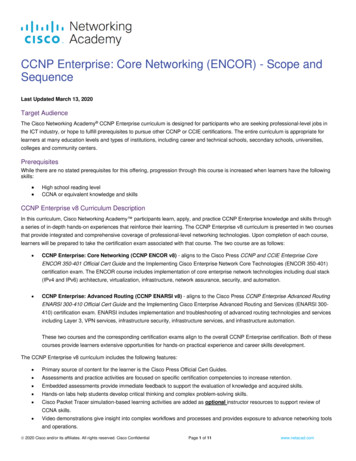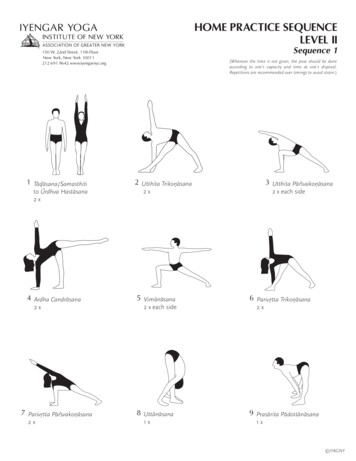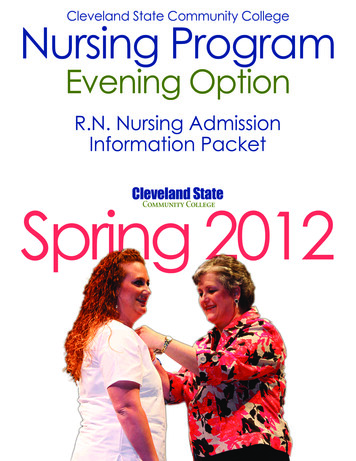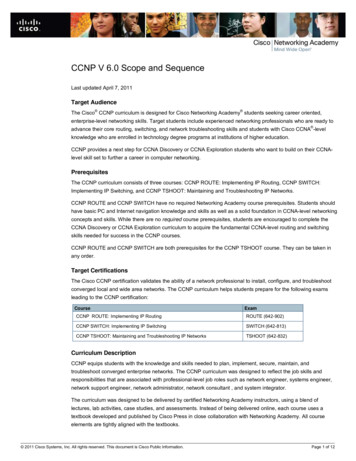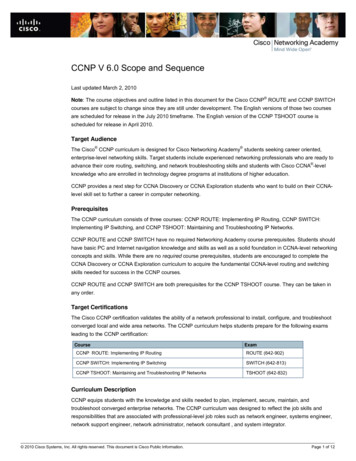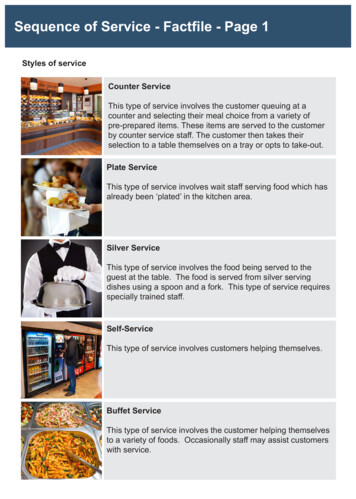
Transcription
Sequence of Service - Factfile - Page 1Styles of serviceCounter ServiceThis type of service involves the customer queuing at acounter and selecting their meal choice from a variety ofpre-prepared items. These items are served to the customerby counter service staff. The customer then takes theirselection to a table themselves on a tray or opts to take-out.Plate ServiceThis type of service involves wait staff serving food which hasalready been ‘plated’ in the kitchen area.Silver ServiceThis type of service involves the food being served to theguest at the table. The food is served from silver servingdishes using a spoon and a fork. This type of service requiresspecially trained staff.Self-ServiceThis type of service involves customers helping themselves.Buffet ServiceThis type of service involves the customer helping themselvesto a variety of foods. Occasionally staff may assist customerswith service.
Sequence of Service - Factfile - Page 2Service StaffRestaurant managerJob TitleJob DescriptionRestaurant ManagerIn charge of running therestaurant.Head waiterSecond in charge. Greetsand seats customers.Wine waiterServes alcoholic drinks tocustomers. Helps gueststo select wines.Waiter/waitressTakes orders, serves foodand clears / sets uptables.Service staff qualitiesPersonalpresentationClean appearance; Clean nails; Clean and brushed hair; Cleanly shaven; Clean andironed uniform; Clean shoes, no trainers; No heavy make-up; No piercings; No badbreath; No body odour; No chewing gum; Good posture.ProfessionalattitudeAttentive; Polite; Respectful; Communicates well; No bad language or slang.Good body language (no slumping, no hands in pockets etc.); Enthusiastic.
Sequence of Service - Factfile - Page 3Preparing for serviceIt is important to create a good first impression on to guests by ensuring thatthe restaurant area is prepared for service, but how is this achieved?1.2.3.4.5.6.7.8.9.10.11.12.13.14.Clean the dining area - vacuum, dust etc.Make sure that the table and chairs are clean.Prepare the dumbwaiter. Refresh condiments, cutlery and relevant serviceequipment e.g. trays.Check and polish the cutlery, crockery and glassware.Organise the tables and chairs.Check for unstable tables and fix if necessary.Lay the cloths and slip cloths onto the tables.Add the napkins.Lay the cutlery onto the tables.Add the glasses.Add the cruets (check if they need re-filling)Add the flowers, candle or table decoration.Add the table number.Ask a supervisor to check everything is up to standard.Table d’hôteCruetsWater glassWineglass (red)Dessert spoonWineglass (white)Place cardDessert forkSide plateNapkinSide knifeFish Fork Joint ForkJoint Knife Fish Knife Soup spoonThis is an example of a table setting for one cover. It would mainly be used for formalsettings such as table d’hôte menus.
Sequence of Service - Factfile - Page 4Classic CoverCruetsWater glassWineglassSide plateNapkinSide knifeSalad ForkJoint ForkJoint Knife Teaspoon Soup spoonThis is an example of an informal table setting for one cover. It would mainly be usedfor informal settings such as a la carte menus.Welcoming and greeting guests Make sure that you welcome all of your customersimmediately at the door of the establishment. Greet your customers with ‘Good morning’, ‘Goodafternoon’ or ‘Good evening’. Add their name if it is knownto give the personal touch, otherwise refer to them as Sir orMadame. Ask your customer if they have made a reservation or if youcan assist them? Lead your customers to their table; introduce yourself or thewaiter that is attending to them. Unfold the napkin and place onto the customer‘s lap. Turnthe wine glasses up. Offer the customer a menu. Take their drinks order. Make sure you ask what size drinkthey would like. Take your order to the bar staff to prepare.Allow the customers time to select their meal.
Sequence of Service - Factfile - Page 5Taking food orders Take the drinks to the table and serve them from the right of the customer. Thenask your customer if they are ready to order their meal. Some customers may want to know specific information about the menu, so beprepared to answer them. You will need to have a good knowledge of your menu inorder to carry this out successfully. If you are unsure, then offer to find out. Stand to the left of the customer when taking the food order. Make sure that youhave good posture and body language. Take the customers’ order using the order pad or electronic waiter pad. Repeat theorder back to the customers to check that it is correct. Change the cover ifnecessary. Don’t forget to ‘upsell’ to your customers. This is when you try to sell somethingextra with their meal, for example side orders. Thank the customers and take theorder to the kitchen.Order padWaiter padTouch screen till
Sequence of Service - Factfile - Page 6Plate and Silver ServiceService styleSequence of servicePlate Meals are already plated up in the kitchen. Take the meals to the table and serve the women and older people first. Serve food from the left of the customer.Silver Serve women and older people first and serve in a clockwise directionaround the table. Serve food from the left of the customer. Meals are not ‘plated’ in the kitchen. Each food item is served at thetable in front of the customer. The waiter holds the service platter with their left hand and serves thefood onto the customers’ plates with their right hand. This is done usinga special technique using a fork and service spoon.AdditionalInformation Ask customers if they would like any condiments with their meal. Check that everything is satisfactory with the meal after a few minutes. Don’t hover around your customers. However, be attentive andrecognise when they require more drinks etc.Clearing after service Ask customers if they have finished before you start to clear up. Clear from the right of thecustomer, however when clearing side plates it is important to do this from the left so that you arenot leaning over your customer. Stand sideways. Clear up as quickly as possible, in as few journeys as possible, without causing accidents. A service plate can be used to assist with clearing up. It can be used to clear dirty cutlery, sideplates, accompaniments and for ‘crumbing down’. Pick up the crockery with your left hand and pass it to your right hand. Stack and clear in theappropriate manner. Crumb down – brush away the crumbs with a folded napkin onto a service tray. Serve the remaining courses.
Sequence of Service - Factfile - Page 1 Styles of service Counter Service This type of service involves the customer queuing at a counter and selecting their meal choice from a variety of.

